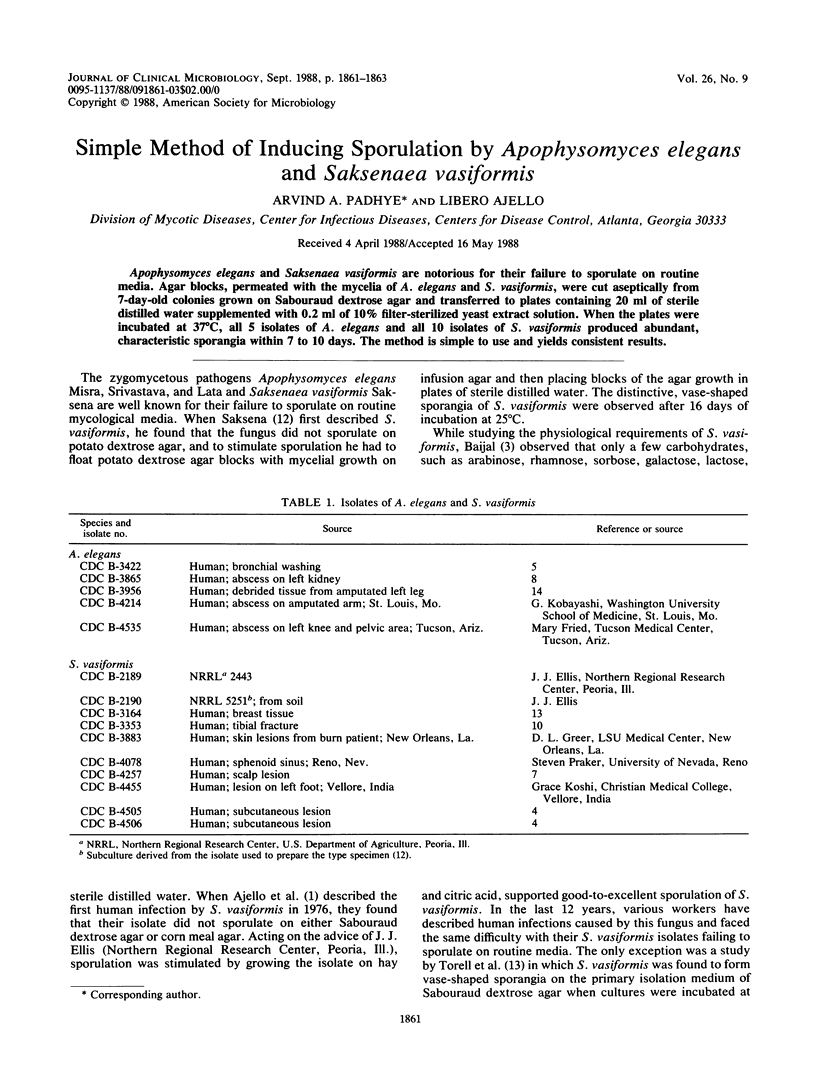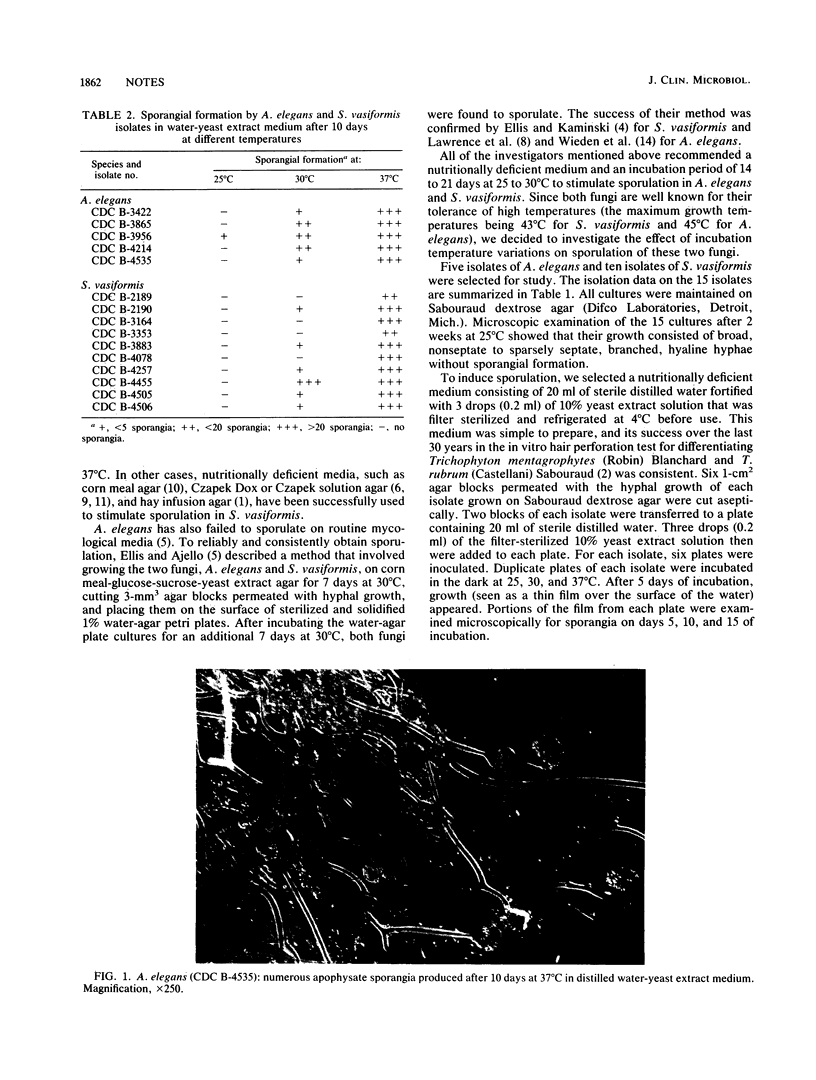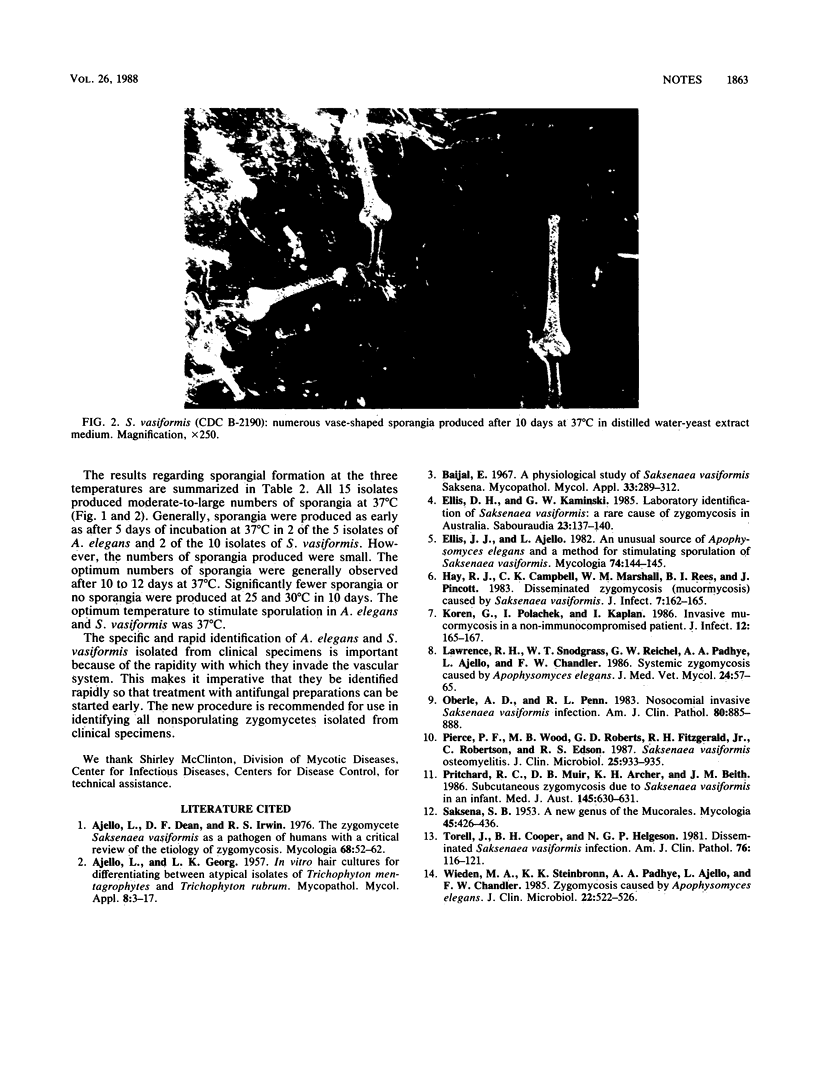Abstract
Apophysomyces elegans and Saksenaea vasiformis are notorious for their failure to sporulate on routine media. Agar blocks, permeated with the mycelia of A. elegans and S. vasiformis, were cut aseptically from 7-day-old colonies grown on Sabouraud dextrose agar and transferred to plates containing 20 ml of sterile distilled water supplemented with 0.2 ml of 10% filter-sterilized yeast extract solution. When the plates were incubated at 37 degrees C, all 5 isolates of A. elegans and all 10 isolates of S. vasiformis produced abundant, characteristic sporangia within 7 to 10 days. The method is simple to use and yields consistent results.
Full text
PDF


Images in this article
Selected References
These references are in PubMed. This may not be the complete list of references from this article.
- AJELLO L., GEORG L. K. In vitro hair cultures for differentiating between atypical isolates of Trichophyton mentagrophytes and Trichophyton rubrum. Mycopathol Mycol Appl. 1957 Mar 25;8(1):3–17. doi: 10.1007/BF02053114. [DOI] [PubMed] [Google Scholar]
- Ajello L., Dean D. F., Irwin R. S. The zygomycete Saksenaea vasiformis as a pathogen of humans with a critical rewiew of the etiology of zygomycosis. Mycologia. 1976 Jan-Feb;68(1):52–62. [PubMed] [Google Scholar]
- Baijal U. A physiological study of Saksenaea vasiformis Saksena. Mycopathol Mycol Appl. 1967 Dec 13;33(3):289–312. doi: 10.1007/BF02088921. [DOI] [PubMed] [Google Scholar]
- Ellis D. H., Kaminski G. W. Laboratory identification of Saksenaea vasiformis: a rare cause of zygomycosis in Australia. Sabouraudia. 1985 Apr;23(2):137–140. doi: 10.1080/00362178585380221. [DOI] [PubMed] [Google Scholar]
- Hay R. J., Campbell C. K., Marshall W. M., Rees B. I., Pincott J. Disseminated zygomycosis (mucormycosis) caused by Saksenaea vasiformis. J Infect. 1983 Sep;7(2):162–165. doi: 10.1016/s0163-4453(83)90695-3. [DOI] [PubMed] [Google Scholar]
- Koren G., Polacheck I., Kaplan H. Invasive mucormycosis in a non-immunocompromised patient. J Infect. 1986 Mar;12(2):165–167. doi: 10.1016/s0163-4453(86)93708-4. [DOI] [PubMed] [Google Scholar]
- Lawrence R. M., Snodgrass W. T., Reichel G. W., Padhye A. A., Ajello L., Chandler F. W. Systemic zygomycosis caused by Apophysomyces elegans. J Med Vet Mycol. 1986 Feb;24(1):57–65. [PubMed] [Google Scholar]
- Oberle A. D., Penn R. L. Nosocomial invasive Saksenaea vasiformis infection. Am J Clin Pathol. 1983 Dec;80(6):885–888. doi: 10.1093/ajcp/80.6.885. [DOI] [PubMed] [Google Scholar]
- Pierce P. F., Wood M. B., Roberts G. D., Fitzgerald R. H., Jr, Robertson C., Edson R. S. Saksenaea vasiformis osteomyelitis. J Clin Microbiol. 1987 May;25(5):933–935. doi: 10.1128/jcm.25.5.933-935.1987. [DOI] [PMC free article] [PubMed] [Google Scholar]
- Pritchard R. C., Muir D. B., Archer K. H., Beith J. M. Subcutaneous zygomycosis due to Saksenaea vasiformis in an infant. Med J Aust. 1986 Dec 1;145(11-12):630–631. [PubMed] [Google Scholar]
- Torell J., Cooper B. H., Helgeson N. G. Disseminated Saksenaea vasiformis infection. Am J Clin Pathol. 1981 Jul;76(1):116–121. doi: 10.1093/ajcp/76.1.116. [DOI] [PubMed] [Google Scholar]
- Wieden M. A., Steinbronn K. K., Padhye A. A., Ajello L., Chandler F. W. Zygomycosis caused by Apophysomyces elegans. J Clin Microbiol. 1985 Oct;22(4):522–526. doi: 10.1128/jcm.22.4.522-526.1985. [DOI] [PMC free article] [PubMed] [Google Scholar]




